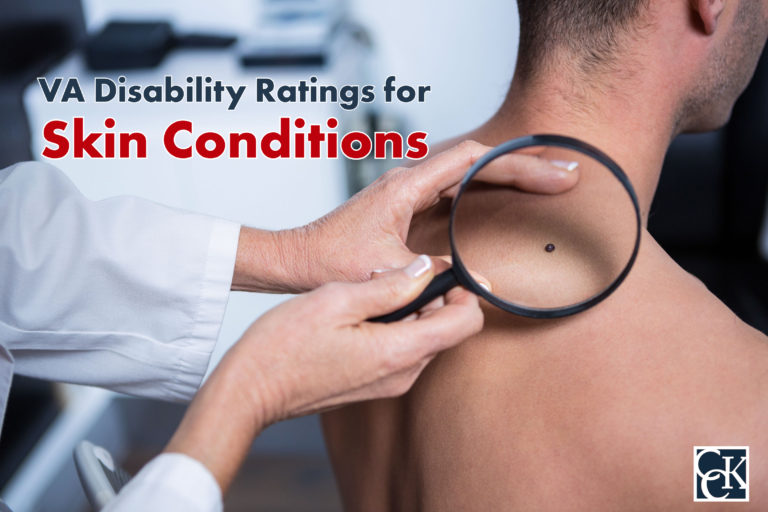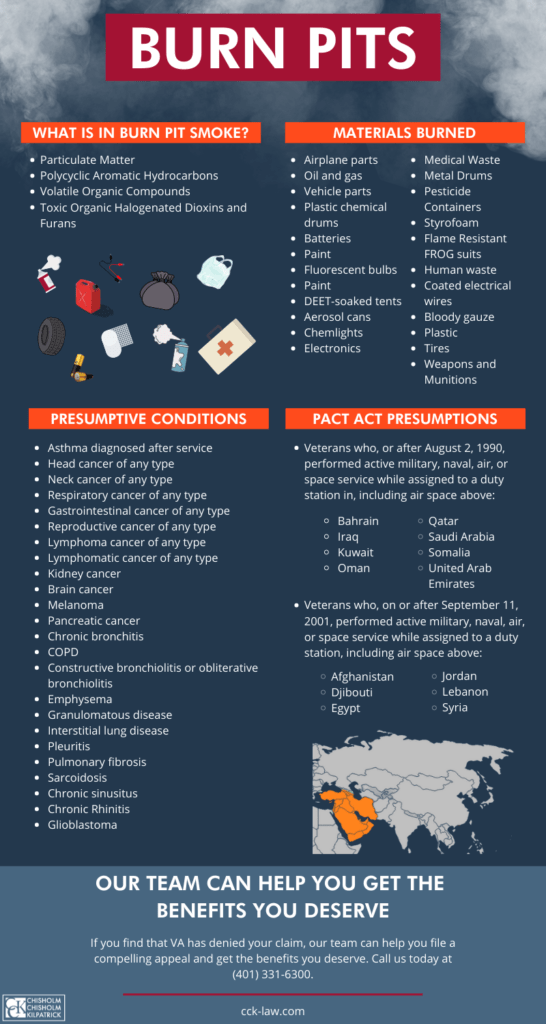VA Disability Ratings for Skin Conditions

VA Updates Disability Rating Schedule Related to Skin Conditions
In August 2018, VA made updates to all 15 body systems included in the Veterans Affairs Schedule for Rating Disabilities to reflect modern medicine more accurately and provide clearer rating decisions. In doing so, VA made changes to how it evaluates conditions related to the skin.
Although no conditions were removed from the new rating schedule for skin conditions, several diagnostic codes were restructured or revised. Importantly, claims pending prior to August 13, 2018 will be considered under both the old and new rating criteria, and whichever is more favorable will be applied.
Overall, under the new rating schedule for skin conditions, VA broadly aims to distinguish between conditions that affect a large portion of the body, or the entire body, and conditions that are localized or require localized treatment.
Common Skin Conditions Among Veterans
There are many skin conditions for which VA assigns ratings, and for which veterans can receive monthly VA disability benefits upon service connection. Below are some of the most common skin conditions affecting veterans:
- Dermatitis, or eczema—This condition refers to general skin irritation which may cause dry skin, a rash, swelling, and reddened skin, as well as blisters.
- Urticaria or hives—Hives are welts in the skin which may be red, swollen, itchy, and can result from a skin reaction. The condition may be chronic if the hives appear for periods of time over months or years.
- Acne, and chloracne—When the pores of the skin are plugged by debris, such as dirt or dead skin cells, acne may form. These inflamed pimples may be painful and cause redness and swelling. Chloracne, which is commonly linked to toxic exposure, is an outbreak of different forms of acne, such as blackheads, pimples, and cysts.
- Psoriasis—This is a skin disorder that causes inflammation and raised plaques, or scales, on the skin.
- Autoimmune disorders of the skin—The immune system is made of cells that can defend the body from skin infections. With autoimmune disorders, these cells may not be able to function as they should, and blisters can form on the skin.
- Skin Cancer—Skin cancer is the most common cancer. There are multiple forms of skin cancer such as basal cell carcinoma, squamous cell carcinoma, and melanoma (i.e., the most serious type of skin cancer).
- Pseudo-folliculitis barbae—This condition affects the beard area of men and can cause inflammation.
Service Connection for Skin Conditions
Direct service connection is very common to pursue when trying to obtain VA disability benefits. To establish direct service connection for a skin condition, veterans will need to demonstrate the following:
- A current diagnosis of a skin condition;
- An in-service event, injury, or illness related to the skin condition; and
- A medical nexus linking the current, diagnosed skin condition to the in-service event, injury or illness.
Presumptive service connection is another way for veterans to pursue entitlement to VA disability benefits. Here, VA has determined that certain conditions are presumed service-connected if veterans fall under certain criteria. Presumptive service connection means that veterans do not have to provide a medical nexus linking their condition to their time in service. Examples of presumptive service connection for skin conditions include the following:
- Veterans who were exposed to herbicide agents (e.g., Agent Orange) while serving in Vietnam and developed chloracne and/or porphyria cutanea tarda within one year of exposure to a degree of 10 percent disabling are afforded presumptive service connection.
- Gulf War veterans with chronic skin conditions (e.g., dermatitis) or with chronic undiagnosed skin disorders can be eligible for presumptive service connection at any time if the condition can be rated at 10 percent or higher.
- “Covered veterans” exposed to burn pits or other toxins during their military service who developed melanoma. This presumption was established under the Honoring Our Promise to Address Comprehensive Toxics (PACT) Act of 2021.

Presumptive Service Connection for Skin Conditions
As mentioned above, veterans who were exposed to certain chemicals or toxins during their service may be eligible for presumptive service connection.
Presumptive Conditions for Vietnam Era Veterans
Veterans who were exposed to herbicide agents while serving in Vietnam and developed chloracne or porphyria cutanea tarda within one year of exposure to a degree of 10 percent disabling are afforded presumptive service connection. Chloracne is a condition where the skin breaks out with different forms of acne such as blackheads, pimples, and cysts while porphyria cutanea tarda is a disorder, which causes painful skin lesions or blisters.
As of the PACT Act, veterans with active military, naval, air, or space service who served in the following locations during the following time periods may qualify for this VA presumption:
- The Republic of Vietnam from January 9, 1962 to May 7, 1975;
- Thailand, at any US or Thai base, from January 9, 1962 to June 30 1976, without regard to the Veteran’s MOS or where on base they were located;
- Laos from December 1, 1965 to September 30, 1969;
- Cambodia, specifically at Mimot or Krek, Kampong Cham Province from April 16, 1969 to April 30, 1969;
- Guam or American Samoa or in the territorial waters thereof from January 9, 1962 to July 30, 1980;
- Johnson Atoll or a ship that called at Johnston Atoll from January 1, 1972 to September 30, 1977;
- On or near the Korean demilitarized zone (DMZ) between September 1, 1967 and August 31, 1971;
- Active duty and reservist personnel who had regular contact with C-123 aircraft between 1969 and 1986.
Presumptive Conditions for Gulf War Veterans
Gulf War veterans with chronic skin conditions, such as dermatitis, or other chronic undiagnosed skin disorders, can be eligible for presumptive service connection at any time if the condition can be rated at 10 percent or higher. For VA purposes, the Persian Gulf War refers to service in the Southwest Asia theater of military operations beginning on August 2, 1990. At present time, the period for the Persian Gulf War extends to December 31, 2026.
Presumptive Conditions for Burn Pit and Toxic Exposure
As of the PACT Act of 2021, “covered veterans” exposed to toxins during their military service can qualify for qualify for presumptive service connection for melanoma, a severe form of skin cancer. A covered veteran is defined as the following:
- A veteran who, on or after August 2, 1990, performed active military, naval, air, or space service while assigned to a duty station in, including air space above:
- Bahrain
- Iraq
- Kuwait
- Oman
- Qatar
- Saudi Arabia
- Somalia
- United Arab Emirates
- A veteran who, on or after September 11, 2001, performed active military, naval, air, or space service, while assigned to a duty station, including the airspace above:
- Afghanistan
- Djibouti
- Egypt
- Jordan
- Lebanon
- Syria
When President Biden officially signed the PACT Act into law, he and VA Secretary McDonough announced that the rollout period for certain presumptive conditions for covered veterans would be waived. Initially, these presumptions were effective upon the date of enactment of the PACT Act only for certain conditions, while presumptions for other conditions would become effective on a rolling basis over the next few years. Now, with this new rollout plan, the presumption for all conditions are effective from the date the PACT Act was signed (August 10, 2022) and VA will begin adjudicating these claims as soon as January 2023. Veterans should know, however, that newly eligibly claimants will not get retroactive benefits back to the date of their original claim unless they are filing a claim for DIC benefits.

How VA Rates Skin Conditions
VA rates skin conditions under 38 CFR § 4.118, Diagnostic Codes 7800-7833. A number of skin conditions are rated based on the amount of skin that is affected. VA’s rating schedule proposes two ways to determine this: calculations and estimations.
Skin area calculations take into account the surface area in inches squared that is affected whereas skin area estimations take into account the percentage of skin that is affected. However, scars on the head, face, or neck are rated based on skin loss and how many facial features have been disfigured.
On the other hand, disability ratings for scars on areas of the body other than the head, face, or neck are generally based on the size of the scar.
The General Rating Formula for the Skin is included in 38 CFR § 4.118 and is used to rate the majority of skin conditions:
- “60 percent – at least one of the following: characteristic lesions involving more than 40 percent of the entire body or more than 40 percent of exposed areas affected; or constant or near-constant systemic therapy including, but not limited to, corticosteroids, phototherapy, retinoids, biologics, photochemotherapy, psoralen with long-wave ultraviolet-A light (PUVA), or other immunosuppressive drugs required over the past 12-month period
- 30 percent – at least one of the following: characteristic lesions involving 20-40 percent of the entire body, or 20-40 percent of exposed areas affected; or systemic therapy including, but not limited to, corticosteroids, phototherapy, retinoids, biologics, photochemotherapy, PUVA, or other immunosuppressive drugs required for a total duration of 6 weeks or more, but not constantly, over the past 12-month period
- 10 percent – at least one of the following: characteristic lesions involving at least 5%, but less than 20 percent , of the entire body affected, or at least 5 percent but less than 20 percent , of exposed areas affected, or intermittent systemic therapy including, but not limited to, corticosteroids, phototherapy, retinoids, biologics, photochemotherapy, PUVA, or other immunosuppressive drugs required for a total duration of less than 6 weeks over the past 12-month period
- 0 percent – no more than topical therapy required over the past 12-month period and at least one of the following: characteristic lesions involving less than 5 percent of the entire body affected; or characteristic lesions involving less than 5 percent of exposed areas affected; or rate as disfigurement of the head, face, or neck (DC 7800) or scars (DCs 7801, 7802, 7804, or 7805), depending upon the predominant disability”
Here, VA defines systemic therapy as any treatment that is injected, or taken by mouth, through the nose, or anally. This includes, but is not limited to, the treatments listed within the rating criteria. VA defines topical therapy as any treatment applied directly to the skin, regardless of the type of drug.
Additionally, veterans may also qualify for Temporary and Total ratings while they are hospitalized or recovering from hospitalization for a skin condition. An example of this may be if a veteran is undergoing radiation treatment for their skin cancer.

How VA Rates Scars
Like skin conditions, VA also awards service connection for scars. Scar disabilities are rated under 38 CFR §4.118, diagnostic codes 7800-7805. Scars are rated based on the number of scars or disfigurements a veteran has, the area of the body affected, their permanence, and the presence of pain or instability.
Specifically, scars on the head, face, or neck, are rated based on skin loss and how many facial features have been disfigured. Ratings for scars on areas of the body, other than the head, face, or neck are generally based on the size of the scar.
Scars can be rated anywhere from 0 to 80 percent, depending on the diagnostic code (DC) used.
- 7800: Scars or disfigurement of the head, face, or neck – ratings based on tissue loss; distortion or asymmetry of features; and characteristics of disfigurement
- Rated at 10, 30, 50, or 80 percent
- 7801: Scars elsewhere on the body that are deep and nonlinear
- Nonlinear scars located in different areas of the body (e.g., one extremity, two separate extremities, front or back of the torso, etc.) are rated separately
- Rated at 10, 20, 30, or 40 percent
- 7802: Superficial nonlinear scars not of the head, neck, or face
- Superficial scars are not permanent in nature and do not affect underlying soft tissue, only the skin
- Rated separately for each area of the body affected
- 10 percent rating
- 7804: Painful or unstable scars
- Unstable scar is one where “there is frequent loss of covering of skin over the scar.”
- If more than one scar is considered unstable, an additional 10 percent may be added to the rating
- Scars rated under diagnostic codes 7800, 7801, 7802, or 7805 can also receive an evaluation under 7804 when applicable
- Rated at 10, 20, or 30 percent
- 7805: Other scars including linear scars
- Ratings based on disabling effects the scar presents
- For example, if a veteran has a linear scar running along the elbow that prevents flexion, they will be rated on limitation of motion of the elbow
Pyramiding and Ratings for Skin Conditions
Skin conditions are often difficult to categorize because each condition can have many different causes and symptoms. As such, veterans often run into problems with pyramiding—the VA term for rating the same disability, or same manifestation (i.e., symptom) twice. Pyramiding is prohibited in VA disability claims by federal law.
However, multiple ratings for skin conditions can be given as long as each condition has a clear and distinct diagnosis, and each condition affects a different area of skin.
For a single condition that affects different skin areas, VA assigns a single rating under that condition which takes into account all affected areas.
For multiple conditions that affect the same area, VA will only rate the condition that gives the higher rating.

Getting Help with VA Claims for Skin Conditions
As mentioned above, claims for skin conditions can be difficult and often complicated, as symptoms and conditions may overlap. An accredited representative or lawyer may be able to assist veterans with their appeals for skin conditions, and specifically help veterans avoid the pitfalls of pyramiding.
The VA disability lawyers at Chisholm, Chisholm & Kilpatrick may be able to help with your skin condition appeal. For a free case evaluation, call our office today at 800-544-9144.
About the Author
Share this Post
